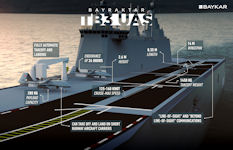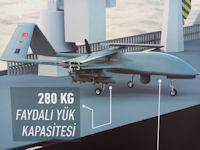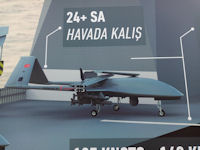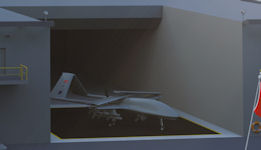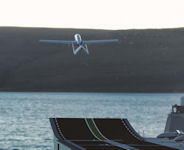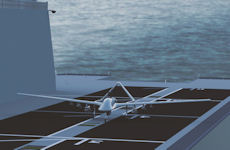Bayraktar TB3 Tactical Armed / UAV System
The Baykar Bayraktar TB3 is a Turkish medium-altitude long-endurance (MALE) unmanned combat aerial vehicle (UCAV) is being created for the Turkish Navy's first amphibious assault ship Anadolu. The Bayraktar TB3 UCAV is an armed unmanned aerial vehicle system, currently being developed indigenously by Baykar and capable of takeoff and landing on short runway aircraft carriers. Besides reconnaissance/surveillance and intelligence missions, the Bayraktar TB3 UCAV can launch an assault operation with the smart munitions stationed under its wings.
Bayraktar TB3 was developed from the Bayraktar TB2. It has folding wings, a payload of SATCOM, a take-off weight of 1450 kilograms, 24-hour airtime, 6 weapon stations, and the ability to operate at high altitudes. Bayraktar TB3 has a wingspan of 14 meters. The drone is just over 8 meters long, 2.6 meters high, and weighs 1,450 kilograms. The maximum speed that develops during the flight reaches 300 km / h, while the cruise speed is 232 km / h. It can carry a payload of 280 kg and stay in the air for a little over 24 hours.
TCG ANADOLU will be able to work with 50 to 110 Bayraktar TB3 depending on the configuration. The Bayraktar TB3 can conduct armed operations overseas due in part to custom capabilities, like foldable wings that enable use on aircraft carriers. The Bayraktar TB3 can be operated from very remote distances thanks to its Line-Of-Sight and Beyond-Line-Of-Sight communications capabilities.
Turkish drone maker Bayka released new details about its newest armed drone, designed to launch from ships packed with unmanned aircraft. “The Bayraktar TB-3, which is still in development, will be a larger and more capable model in the same family as the TB-2,” the company’s chief technology officer, Selcuk Bayraktar, said during an 04 August 2021 online presentation sponsored by Gebze Technology University. “When we began this project, no fixed-wing UAV could take off from LHD-class, short-runway ships,” he explained. “We believe that the TB-3, which can stay in the air for an extended period and is equipped with ammunition, will fill a gap in this field,” Bayraktar said. “A simple roller system and rescue nets would be enough for secure takeoff and landing, and it can even land without a rescue net.” The roller system will be powered by an electric motor. During landing, the drone will be secured with nets. Because the propellers are located at the back of the platform, no moving parts would be damaged during this process, the thinking goes.
UAVs generally return to the same location for landing from which they were launched so that the human operators can recover the UAVs and repair and/or prepare them for another flight. Using a net for recovery is a pretty straight forward solution. The technique is to have a vertically mounted net that the UAV flies into for a quick landing. A simple and reliable technique that does not involve complex components. A problem with net recovery is that it can damage the UAV as the deceleration is rather quick and there is a risk of entanglement in the net that can damage propellers.
A system for halting a flight of an aircraft may include two line support mechanisms supported above a base surface (e.g., the flight deck) and separated by a space, a capture line suspended between the two line support mechanisms, an actuator system configured to move the two line support mechanisms to cause the capture line to travel through a capture window, a spooling system configured to extend or retract the capture line from the two line support mechanisms, and a recovery control system. The recovery control system may be configured to, in response to detecting a condition, activate the actuator system to move the two line support mechanisms, thereby moving the capture line through the capture window and engaging an engagement member on the aircraft with the capture line. The recovery control system may be further configured to measure a force on the capture line, and cause the spooling system to extend the capture line to maintain the measured force on the capture line under a threshold.
A fixed-wing UAV based on a ship is much more restricted in the launch procedure than the ones used on land. Apart from the smallest types of UAVs that can be launched by hand, UAVs need means to accelerate up to a certain speed to be able to take-off. Conventionally a runway is used where the UAV accelerates by its own propulsion, but on a corvette or frigate the space is too limited to allow for this. Instead measures have to be taken to assist in the take-off. This can be done in several different ways.
Typical launch methods for fixed-wing UAVs can include human-powered launch by hand, or on a rail system typically powered by pneumatic, pyrotechnic, elastomeric ("bungee cord"), or electromagnetic subsystems. Basic methods of launch require operator interaction to prepare the launcher as well as the UAV, with pre-flight checks, for example. In order for a UAV launcher to achieve the smallest possible launch distance, energy must be applied to the aircraft within the smallest period of time and without exceeding the aircraft's acceleration limits. This is generally accomplished by applying a constant force to the aircraft uniformly over the launch distance. While the use of energy storage devices such as pneumatic cylinders have been used to launch unmanned aircraft, use of such storage devices generally results with energy increasing linearly with displacement.
A pneumatic launcher is basically a device that uses compressed air (or some kind of gas) to launch something. Typically, there is an air chamber pressurized with air. All this air is released suddenly and this energy is what propels a projectile or any other object such as but not limited to unmanned air vehicle (UAV). There are many different types of pneumatic launchers. The air can be released by several different methods. One type of pneumatic launcher is a UAV pneumatic catapult launcher is intended to accelerate UAVs to launch speed. The UAV pneumatic catapult typically include attachable rail parts, assembled length of couple of meters, carriage with pulling cable, battery operated air compressor with compressed air reservoir and pneumatically operating main valve with remote trigger.
The term "roller system" is not common nomenclature for UAV launch systems. Presumably the electric motor turns the winch that pulls the cradle and accelerating the UAV to launch speed. Such a launch system is much more complex then bungee cord or rocket and requires electrice power to operate. Advantages are that it can produce relatively high launching velocities and the initial start can be softened to avoid too high accelerations. This leads to the solution being more forgiving on the design of the UAV as it does not need to support high accelerations.
Baykar Defense General Manager Haluk Bayraktar announced 08 March 2022 that the Bayraktar TB3 UAV will be suitable for Japanese Izumo-class mini aircraft carriers. Baykar’s general manager for defense, Haluk Bayraktar, said: “China will not want to sell drones to many Asian countries around it, and we offer those countries a better option. Asian countries are showing great interest in our products”. Bayraktar said: “The TB3, which will soon make its first flight, will be very suitable for Japanese Izumo-class platforms. The folding wings of UAVs will allow the carrier to accept more UAVs than fixed-wing aircraft. Japan must acquire armed drones as soon as possible”. Officially described as a “multi-role destroyer”, the Izumo is the main ship of the Japanese Navy’s self-defense force.
| Wingspan | 14 Meters |
| Length | 8.35 Meters |
| Height | 2.6 Meters |
| Maximum Take Off Weight | 1450 Kilograms |
| Cruise Speed | 125 knots |
| Maximum Speed | 160 knots |
| Payload Capacity | 280 Kilograms |
| Endurance | 24+ Hours |
| Advanced Features |
|
|
NEWSLETTER
|
| Join the GlobalSecurity.org mailing list |
|
|
|


